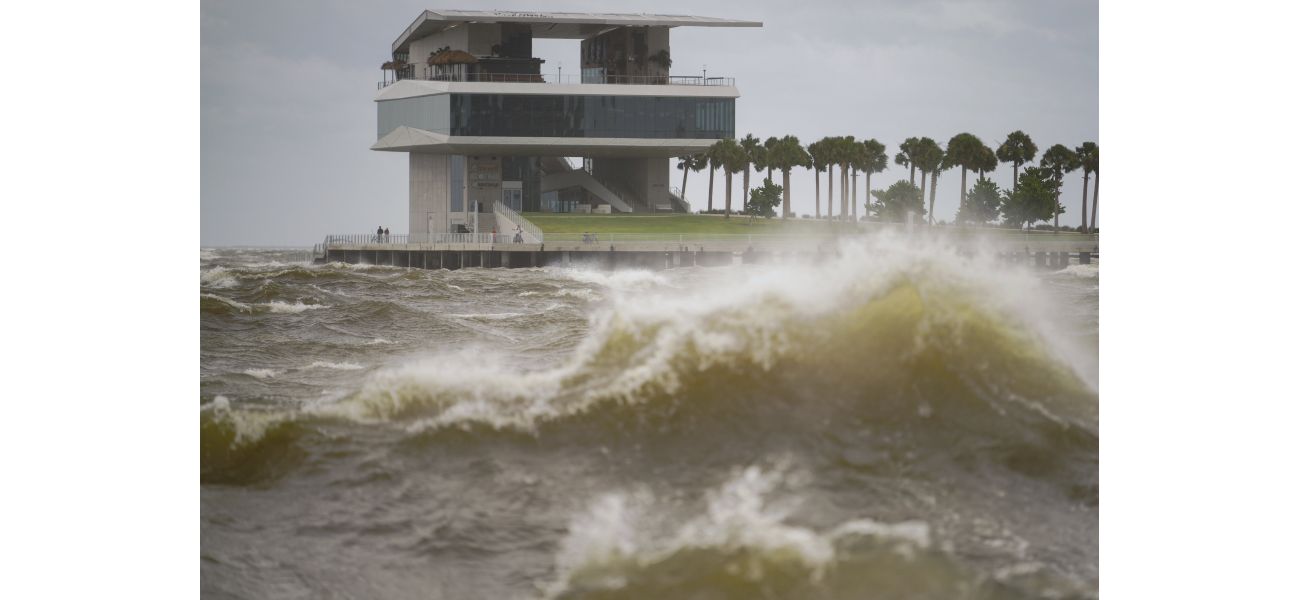Hurricane Helene hits northwestern Florida as a Category 4 storm.
Several states have declared emergencies due to powerful winds causing power outages for over 250,000 properties.
September 27th 2024.

The people of Florida's northwestern coast were bracing themselves for the arrival of Hurricane Helene, a powerful Category 4 storm that made landfall on Thursday evening. As it approached, forecasters warned of the potential for catastrophic storm surges, damaging winds, and flash floods that could reach hundreds of miles inland across the southeastern United States.
The storm had already caused devastation in its wake, with two fatalities reported in Georgia due to a possible tornado and one person losing their life while driving on Interstate 4 in Florida when a sign fell onto their car. The strong winds and heavy rains also knocked out power to over 1 million homes and businesses in Florida and over 50,000 in Georgia.
States of emergency were declared in Florida, Georgia, the Carolinas, Virginia, and Alabama, as the storm continued its destructive path. Meanwhile, in the Pacific, former Hurricane John had strengthened back into a hurricane and was threatening areas of Mexico's western coast with flash flooding and mudslides.
Back in the Atlantic Ocean, another storm was brewing. Tropical Storm Isaac had formed on Wednesday and was expected to strengthen as it moved east away from the United States. Forecasters were predicting that it could become a hurricane by the end of the week.
As the storm made landfall in northwestern Florida, Governor Ron DeSantis urged people to stay safe and seek shelter. He also warned that there could be more fatalities and property damage as the storm continues to advance. The National Guard was on standby, ready to respond and assist those in need.
Despite the warnings, the hurricane made landfall near Perry, Florida, around 11:10 p.m. EDT, with maximum sustained winds of 140 mph. The National Hurricane Center in Miami issued a storm surge warning of up to 20 feet, particularly in Florida's Apalachee Bay, warning that it could be catastrophic and unsurvivable.
As the storm continued to wreak havoc, power outages continued to rise. By 11 p.m. EDT, over 885,000 customers in Florida were without power, with the majority of those in counties near the expected landfall of Hurricane Helene.
In the midst of all this chaos, former Hurricane John was downgraded to a tropical storm and was slowly moving along the coast of Mexico's Michoacan state. However, the storm was still a threat, with sustained wind speeds of 70 mph and the potential for severe flash flooding.
John had first made landfall in Acapulco on Monday as a Category 3 hurricane, causing significant damage and destruction. After weakening and reemerging over the ocean, it had strengthened back into a hurricane on Thursday, only to be downgraded once again to a tropical storm.
The US National Hurricane Center warned that John was expected to continue weakening and eventually dissipate on Friday. However, the damage it had already caused was a reminder of the immense power and destruction that these storms can bring.
The winds were fierce and the rain was relentless as Hurricane Helene descended upon the northwestern coast of Florida on Thursday evening. With a Category 4 status, this fast-moving storm brought with it the threat of a catastrophic storm surge, damaging winds, and flash floods that could reach hundreds of miles inland across the southeastern United States.
As the storm approached, authorities in Georgia reported two fatalities from a possible tornado in the southern part of the state. And tragically, Florida Governor Ron DeSantis confirmed that one person lost their life while driving on Interstate 4 when a sign fell onto their car. Power outages were widespread, affecting over 1 million homes and businesses in Florida and over 50,000 in Georgia, according to the tracking site poweroutage.us.
The situation was dire, and states of emergency were declared in multiple states, including Florida, Georgia, the Carolinas, Virginia, and Alabama. Meanwhile, in the Pacific, former Hurricane John regained its strength on Thursday morning, becoming a hurricane once again as it threatened the western coast of Mexico with flash flooding and mudslides. It was later downgraded to a tropical storm as it slowly moved along the coast of Michoacan.
In the Atlantic, another tropical storm, Isaac, formed on Wednesday and was expected to intensify as it moved away from the United States, potentially becoming a hurricane by the end of the week, according to forecasters.
The devastation caused by Hurricane Helene was already being felt, with one reported fatality in Florida and more expected as the storm continued to advance. Governor DeSantis urged residents to stay safe and hunker down, warning that the dangerous conditions posed a significant threat to lives and property. He also announced that 3,500 National Guardsmen were ready to respond to the aftermath of the storm.
As the night wore on, the National Hurricane Center in Miami reported that Helene had made landfall near the town of Perry, Florida, in the Big Bend area of the state's Gulf Coast. With maximum sustained winds of 140 mph, this powerful storm was expected to bring catastrophic flooding to the Gulf Coast, particularly in Florida's Apalachee Bay. Hurricane and flash flood warnings were in place for areas far beyond the coast, including northern Georgia and western North Carolina.
The aftermath of Hurricane Helene was evident in the rising number of power outages, with over 885,000 customers in Florida left without electricity by 11 p.m. EDT. The majority of these outages were concentrated in the Big Bend area where the storm made landfall.
In the Pacific, John was no longer a hurricane, having been downgraded to a tropical storm on Thursday evening. However, it still posed a threat to coastal areas of Mexico, with sustained winds of 70 mph and the potential for severe flash flooding. The storm first hit Mexico as a Category 3 hurricane on Monday, causing extensive damage and casualties before reemerging over the ocean and regaining its strength.
As the slow-moving storm continued to creep along the coast of Michoacan, the National Hurricane Center warned that it could weaken further on Thursday night and into Friday. The impact of Hurricane John was felt far and wide, highlighting the need for caution and preparedness in the face of such powerful natural disasters.
The storm had already caused devastation in its wake, with two fatalities reported in Georgia due to a possible tornado and one person losing their life while driving on Interstate 4 in Florida when a sign fell onto their car. The strong winds and heavy rains also knocked out power to over 1 million homes and businesses in Florida and over 50,000 in Georgia.
States of emergency were declared in Florida, Georgia, the Carolinas, Virginia, and Alabama, as the storm continued its destructive path. Meanwhile, in the Pacific, former Hurricane John had strengthened back into a hurricane and was threatening areas of Mexico's western coast with flash flooding and mudslides.
Back in the Atlantic Ocean, another storm was brewing. Tropical Storm Isaac had formed on Wednesday and was expected to strengthen as it moved east away from the United States. Forecasters were predicting that it could become a hurricane by the end of the week.
As the storm made landfall in northwestern Florida, Governor Ron DeSantis urged people to stay safe and seek shelter. He also warned that there could be more fatalities and property damage as the storm continues to advance. The National Guard was on standby, ready to respond and assist those in need.
Despite the warnings, the hurricane made landfall near Perry, Florida, around 11:10 p.m. EDT, with maximum sustained winds of 140 mph. The National Hurricane Center in Miami issued a storm surge warning of up to 20 feet, particularly in Florida's Apalachee Bay, warning that it could be catastrophic and unsurvivable.
As the storm continued to wreak havoc, power outages continued to rise. By 11 p.m. EDT, over 885,000 customers in Florida were without power, with the majority of those in counties near the expected landfall of Hurricane Helene.
In the midst of all this chaos, former Hurricane John was downgraded to a tropical storm and was slowly moving along the coast of Mexico's Michoacan state. However, the storm was still a threat, with sustained wind speeds of 70 mph and the potential for severe flash flooding.
John had first made landfall in Acapulco on Monday as a Category 3 hurricane, causing significant damage and destruction. After weakening and reemerging over the ocean, it had strengthened back into a hurricane on Thursday, only to be downgraded once again to a tropical storm.
The US National Hurricane Center warned that John was expected to continue weakening and eventually dissipate on Friday. However, the damage it had already caused was a reminder of the immense power and destruction that these storms can bring.
The winds were fierce and the rain was relentless as Hurricane Helene descended upon the northwestern coast of Florida on Thursday evening. With a Category 4 status, this fast-moving storm brought with it the threat of a catastrophic storm surge, damaging winds, and flash floods that could reach hundreds of miles inland across the southeastern United States.
As the storm approached, authorities in Georgia reported two fatalities from a possible tornado in the southern part of the state. And tragically, Florida Governor Ron DeSantis confirmed that one person lost their life while driving on Interstate 4 when a sign fell onto their car. Power outages were widespread, affecting over 1 million homes and businesses in Florida and over 50,000 in Georgia, according to the tracking site poweroutage.us.
The situation was dire, and states of emergency were declared in multiple states, including Florida, Georgia, the Carolinas, Virginia, and Alabama. Meanwhile, in the Pacific, former Hurricane John regained its strength on Thursday morning, becoming a hurricane once again as it threatened the western coast of Mexico with flash flooding and mudslides. It was later downgraded to a tropical storm as it slowly moved along the coast of Michoacan.
In the Atlantic, another tropical storm, Isaac, formed on Wednesday and was expected to intensify as it moved away from the United States, potentially becoming a hurricane by the end of the week, according to forecasters.
The devastation caused by Hurricane Helene was already being felt, with one reported fatality in Florida and more expected as the storm continued to advance. Governor DeSantis urged residents to stay safe and hunker down, warning that the dangerous conditions posed a significant threat to lives and property. He also announced that 3,500 National Guardsmen were ready to respond to the aftermath of the storm.
As the night wore on, the National Hurricane Center in Miami reported that Helene had made landfall near the town of Perry, Florida, in the Big Bend area of the state's Gulf Coast. With maximum sustained winds of 140 mph, this powerful storm was expected to bring catastrophic flooding to the Gulf Coast, particularly in Florida's Apalachee Bay. Hurricane and flash flood warnings were in place for areas far beyond the coast, including northern Georgia and western North Carolina.
The aftermath of Hurricane Helene was evident in the rising number of power outages, with over 885,000 customers in Florida left without electricity by 11 p.m. EDT. The majority of these outages were concentrated in the Big Bend area where the storm made landfall.
In the Pacific, John was no longer a hurricane, having been downgraded to a tropical storm on Thursday evening. However, it still posed a threat to coastal areas of Mexico, with sustained winds of 70 mph and the potential for severe flash flooding. The storm first hit Mexico as a Category 3 hurricane on Monday, causing extensive damage and casualties before reemerging over the ocean and regaining its strength.
As the slow-moving storm continued to creep along the coast of Michoacan, the National Hurricane Center warned that it could weaken further on Thursday night and into Friday. The impact of Hurricane John was felt far and wide, highlighting the need for caution and preparedness in the face of such powerful natural disasters.
[This article has been trending online recently and has been generated with AI. Your feed is customized.]
[Generative AI is experimental.]
0
0
Submit Comment





